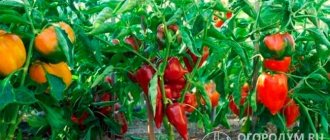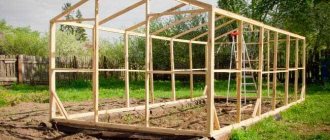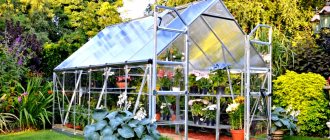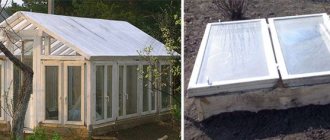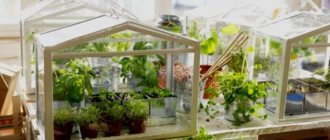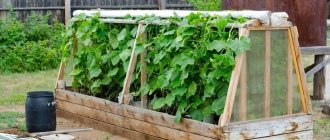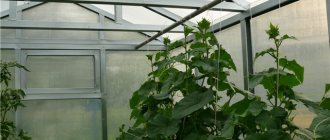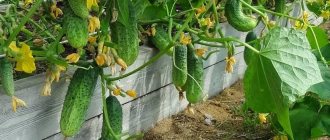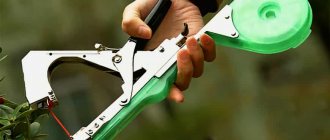Zucchini is an unpretentious crop, so in most cases it is grown in open ground. However, this does not mean that they cannot be cultivated in greenhouse conditions. On the contrary, this will allow you to harvest a richer harvest - on average up to 30 kg of fruits per 1 sq. m. We will find out further what needs to be taken into account when growing this vegetable crop in a greenhouse, and how to properly care for it.
Advantages of growing indoors
Zucchini is rarely grown in greenhouse conditions, since it produces a good harvest in the garden. Moreover, they are resistant to night cold and require little maintenance. However, even taking this into account, their cultivation in a greenhouse is not without meaning, as it offers the following advantages:
- the fruits ripen several times faster, which has a positive effect on the amount of harvest;
- when formed, the zucchini acquires a more delicate and delicious taste;
- hybrids intended for cultivation under film conditions do not require special attention in care;
- seedlings are not attacked by pests and practically do not get sick;
- early varieties can be profitably grown for sale on an industrial scale.
Zucchini does not require special soil composition and temperature conditions, so growing them indoors is inexpensive.
Brief information about zucchini
Zucchini came to us from warmer countries. Therefore, the requirements for their cultivation are quite high. Zucchini really needs a lot of light, strong sunlight is the basis for successfully growing this vegetable.
In addition, for a good harvest, temperatures above 20-25 degrees Celsius are needed. However, the growing season of the vegetable is short-lived and characterized by rapid growth rates, so if grown correctly, you will have a good harvest by autumn.
Zucchini needs a rich substrate. For this reason, in the fall it is worth spreading well-fermented compost over the beds or feeding the soil with a starter, multi-component mineral fertilizer for vegetable plants. Zucchini also loves moist soil, so do not forget about high-quality watering.
Variety selection
For growing in a limited space, it is best to choose compact bush hybrids F1, since they simultaneously meet several important requirements - they take up minimal space, have high yields and a long fruiting period, and have excellent taste. If you also choose early hybrids, you can grow them in a greenhouse throughout the year.
For sale, small-fruited varieties with zucchini of a light or medium-saturated color are more preferable. It is important that the plant itself does not have growths on the petioles to make it easier and safer to harvest numerous crops.
Taking into account the listed requirements, it is best to cultivate the following varieties and hybrids indoors:
- Kuand F1. An early ripening variety bred at the Kuban Experimental Station of the All-Russian Research Institute of Plant Growing. Recommended for growing in protected ground under a small-sized film cover in the Northern, Volga-Vyatka, Lower Volga, Ural and West Siberian regions. Fruiting occurs 52-61 days after the appearance of full shoots. Productivity – 20-25 kg per 1 sq. m. Fruits weighing 1.1-1.5 kg and 21-28 cm long are excellent for processing and canning.
- Cavili. A hybrid of Dutch selection with a long fruiting period (more than 2 months). Typically, straight zucchini is harvested 45-50 days after emergence when they reach a length of 16-22 cm. For 10 sq. m of greenhouse, it is enough to plant only 8-12 plants. Productivity – 10-60 t/ha.
- Nemchinovsky. A hybrid variety of compact size that does not form long vines and bears fruit with pale green zucchini weighing 610-770 g. The plant is early ripening, so it begins to bear fruit on 38-48 days. Characterized by friendly yield of fruits.
- Aral F1. Replenishes the list of the fastest-growing early zucchini - the first fruits can be harvested already on the 35th day. When zucchini reaches technical ripeness, it weighs about 0.5 kg and reaches a length of 16-18 cm. The yield is high - more than 500 kg/ha. When grown in a greenhouse, fruits should be collected every 3-4 days, which will contribute to the formation of new ovaries.
- Daredevil. Another early ripening variety of zucchini, technical ripeness of which occurs in 35-50 days. On average, the fruits weigh from 0.5 to 1 kg and have excellent transportability.
Zucchini varieties recommended for greenhouses
Bush hybrids are best suited for greenhouses. They are not only characterized by increased yield and excellent taste, but also take up quite little space. The most common are:
Belogor
Zucchini Belogor
High-yielding variety of early ripening. Medium sized fruits. The pulp is quite dense with a delicate taste. Suitable for both preservation and fresh use.
Cavili
Zucchini Kavili
Belongs to early ripening varieties. It has oblong fruits of white-green color. The pulp is dense, without a bitter aftertaste. Used for making soup, stew, and canning.
Kaund
Zucchini Kaund
High-yielding, early-ripening variety. The fruits are medium sized, smooth. The pulp is greenish-white, tender, dense, juicy.
Greenhouse requirements
Zucchini grows well in polycarbonate greenhouses and in simple film shelters. In any case, to obtain a good harvest, it is worth taking into account a number of requirements for the greenhouse:
- Even to obtain a good harvest, the greenhouse area can be small - about 45-50 square meters. m. Its height is not particularly important, but for ease of caring for plants and harvesting, it is worth maintaining a wide passage between the bushes.
- If you plan to grow vegetables in the winter season, the greenhouse should be built on a foundation, and wooden or metal frames should be covered with glass or polycarbonate. Additionally, it must be equipped with vents for ventilation and a heating system using an electric boiler or wood stoves. If the greenhouse is simply covered with plastic, then you can use household air heaters. In expensive greenhouses, it is possible to provide a system of automatic drip irrigation and climate control.
- For zucchini, it is advisable to provide biofuel that will warm not so much the air, but rather the roots of the plants. Such a pillow is prepared by mixing equal amounts of straw with rotted manure (pork, goat or cow). The resulting pile must be folded, watered well and left under film for 3-4 days. Next, in the greenhouse you need to remove the top layer of soil, evenly distribute the biofuel and cover it with a layer of nutrient substrate.
Such a pillow is also an excellent feed for seedlings during the period of active growth, since it emits carbon dioxide, which promotes the rapid ripening of fruits and improves their taste.
- For zucchini in a greenhouse, you need to prepare light, oxygen-filled soil with a slightly alkaline or neutral reaction. Before planting, it can be fertilized with ash or mineral fertilizers. It must be taken into account that vegetable crops do not like to grow in the same place year after year. It is best to alternate planting it with the following crops: onions;
- cabbage;
- garlic;
- legumes;
- carrots;
- tomatoes;
- potatoes.
To enrich and improve the soil structure, it is recommended to plant green manure.
How to distinguish zucchini seedlings from pumpkins or cucumbers
Sometimes gardeners move seedlings from window sill to window sill, wanting to provide all plants with enough light, and then ask themselves the question: “How to distinguish zucchini seedlings from pumpkins and cucumbers?” Unfortunately, this is not very simple, but there are some characteristic features.
In zucchini, the first true leaf is usually very thin, and the stem is long and pale green.
Pumpkin has a thicker and shorter stem. At the same time, it, as well as the young leaves, are painted dark green. In addition, pumpkin leaves are usually somewhat larger, denser and coarser in texture than those of zucchini.
In cucumber, the most noticeable distinguishing feature during the cotyledon phase is the thinner stem. When the real leaves appear, squash and pumpkin begin to grow rapidly, but cucumber usually lags behind.
Method and timing of planting
In open ground, zucchini can be grown both by seedlings and seeds, but in a greenhouse it is much more effective to use seedling technology. It can be used throughout the year, but it is best to do this at the end of winter - beginning of spring, since autumn zucchini have the best shelf life (they last 2-4 months). In addition, it is by spring that the body most needs vitamin support.
If you start growing seedlings at the end of February or early March, the first harvest can be harvested around the beginning of April.
Experienced gardeners have noticed that the exact timing of planting seedlings in a greenhouse depends on their location. In Moscow, its picking into the ground should be done on May 5-10, in Siberia - on May 15-20, and in the Krasnodar Territory - on April 10-15.
Reviews from gardeners
Alekseevna
Zucchini, in principle, is a problem-free crop. It is not necessary to grow seedlings, why do you need the extra trouble. The main thing is your own seeds, reliable ones.
Source: forum.tvoysad.ru
AndreyV
Zucchini is such a problem-free and rewarding crop that somehow you don’t even think about yield, timing, etc.
Source: forum.prihoz.ru
Growing seedlings
To get a good harvest of zucchini, you need to grow strong seedlings in early March. This procedure can be divided into several stages, each of which requires separate consideration.
Seed preparation
Seeds even after 6-8 years of storage germinate quite well. However, for this they need to be properly prepared, following these instructions:
- Pour hot water (+45...52°C) over the seeds and leave for 5-7 hours. Specimens that float to the surface within the first few minutes are hollow and should be fished out and discarded.
- To reduce the risk of developing fungal diseases, immerse the remaining seeds in ice water for 2 minutes.
- Wrap the seed material in a damp cloth and keep it for 2 days in a room where the temperature is at least +23°C. During this time, keep the fabric damp.
Immediately before planting, the seeds can be soaked for several minutes in a solution of a stimulant or potassium permanganate.
Planting seeds
Zucchini seeds are large, so they should be grown in separate containers. Considering that the plant does not tolerate replanting well, it is better to use individual peat pots with a diameter of 10 cm or more for this. If there are none, you can use plastic or wooden analogues.
You can buy soil for seedlings at a garden store or prepare it yourself by mixing:
- 7 parts of garden soil;
- 5 parts peat;
- 3 parts mullein;
- 150-200 g of ash;
- 30-40 g of superphosphate;
- 25-40 g of ammonium nitrate.
You need to fill the pots halfway with this nutrient composition. It needs to be well moistened a day before sowing. When planting, the seeds need to be deepened into the soil by 1.5-3 cm. If they have sprouts, then they need to be planted with the hatched sprouts facing down. It is worth dropping 2 seeds into each hole. After sowing, the soil should be lightly watered and then covered with film or glass.
In 3-5 days, most of the seeds will germinate, but only the strongest sprouts should be left in the pots. The rest must be carefully cut above ground level. Under no circumstances should they be pulled out, as this can damage the entire root system of the plant.
Seedling care
After sowing the seeds, all that remains is to provide proper care for the seedlings, which involves observing the following rules:
- Until the first shoots appear, keep the pots at a temperature of +26...+28°C. When the first shoots appear, lower it to +17-18°C during the day, and to +12...+14°C at night. This regime must be maintained for 4 days, and in the future it must be adjusted depending on weather conditions and time of day. So, on cloudy days the optimal temperature is +21-22°C, and on sunny days – +26...+28°C. At night it should be maintained at +17-18°C.
- Excessive watering should not be allowed, as well as the formation of a crust on the surface of the soil. All this can lead to the development of stem and root rot. To prevent this, seedlings need to be irrigated with warm water as the soil dries out.
- When growing seedlings on a south-facing windowsill, the sprouts do not require additional lighting. On the east or west side there is at least 11 hours of daylight, so there is also no need for incandescent lamps. However, they will be required if seedlings are grown on a windowsill on the north side.
At the age of 20-25 days, the seedlings will acquire 3-4 true leaves. At this stage, it can be transplanted to a permanent location.
Diseases and pests
| copperhead Ways to fight:
| |
| Powdery mildew Ways to fight:
| |
| Angular leaf spot (Bacteriosis) Ways to fight:
|
Planting seedlings in a greenhouse
The soil in the greenhouse in which zucchini will be planted must be well prepared. To do this, it is advisable to add rotted manure to it in the fall at the rate of 10 kg per 1 sq. m. m and dig it well. Mineral fertilizers can be applied directly to the holes before sowing at the rate of 30-40 g of nitrophoska per plant. After application, they need to be mixed with the soil in the hole.
Seedlings are often transplanted to a permanent location in early May or a little earlier. Before this, you need to warm up the soil using a stove or electric boiler. To maintain a normal level of humidity in it and ensure rapid maturation of the crop, it is worth mulching with sawdust, sunflower husks or other organic matter.
Picking should be done in the morning, evening or on a cloudy day. This should be done using the square-cluster method according to the following scheme:
- distance between holes – 0.7-0.8 m;
- row spacing – from 0.8 to 1.5 m.
The seedlings need to be planted into the holes together with a lump of earth and deepened into the soil by 5 cm, and then sprinkled with earth to the first leaves, lightly tamped and watered. At this stage, the temperature in the greenhouse should be +14-15°C. It is necessary to ventilate the room in such a way as not to lower it too much. The plantings can be covered with film, in which holes can be made for each plant. In the future, watering should be carried out into these holes.
Preparing seeds for planting
In order for the seeds to germinate faster and the seedlings to be friendly, they need to be properly prepared.
Checking seeds for germination
First you need to prepare sawdust, which is first poured with boiling water several times every half hour. After that, they are poured into a small box. Seeds are laid out in rows on top of the sawdust. A distance of 1–1.5 cm is left between them, and 2–3 cm between the rows. Then the planting material to be tested is sprinkled with sawdust and compacted by hand. The box should be located in a room with a temperature of +23–27˚С. After emergence, the number of sprouted seeds is counted. To make it easier to calculate the percentage of germination, it is better to plant 10 seeds per germination.
To check the germination of seeds, they are wrapped in damp gauze and placed in a warm place for germination.
Soaking and germination
To soak the seeds you will need a small container and a piece of gauze. The seeds are evenly laid out on a damp cloth and covered with another layer on top. Then they are filled with water at a temperature no higher than +35˚C, after which the container is placed in a dark place. During soaking, you need to monitor the condition of the water and periodically replace it with fresh water. The soaking period should last no more than 16–20 hours, which is quite enough to soften the shell and swell the seed material.
The water must be replaced as soon as its color changes from clear to brown.
Zucchini seeds can be soaked not in ordinary water, but in special solutions that will help improve growth and stimulate productivity. Nutrients and growth stimulants should be diluted in warm water at a temperature of about +25˚С. For germination, you can use one of the following solutions:
- Dissolve 1 tsp in 1 liter of water. nitrophoskas or nitroammophoskas;
- dilute potassium permanganate in warm water to make a pink solution, and add half a tablet of any microelements;
- Dilute 1 tsp in 1 liter of water. Kristalin or Rost-1 products;
- add 1 tbsp to 1 liter of warm water. l. wood ash.
To improve the germination of seed material, it is soaked in growth stimulants
Germination is carried out similarly to soaking: seeds in gauze are placed in a container and filled with a small amount of nutrient solution so that the liquid only covers the fabric. The seeds should remain in this state for 3–4 days before sprouts appear.
Caring for zucchini in a greenhouse
This vegetable crop is unpretentious even in open ground, so it is quite easy to care for it, especially if you know the secrets of carrying out the necessary agrotechnical measures:
- Creating an optimal microclimate . The plant does not grow well in conditions that are too hot and humid in greenhouses. The ideal temperature for the full development of seedlings during the day is +24°C, and at night – +18°C. Zucchini does not tolerate stuffiness well, so the greenhouse must be ventilated daily to maintain humidity at 60-70%. At the end of April - beginning of May, the frequency of ventilation should be increased.
- Watering and loosening. Seedlings should be watered with warm, settled water (+19…+24°C) not often, but abundantly. With the appearance of the first ovary on the bushes, the amount of watering should be increased to 3 times a week. During this period, it is worth pouring 4 liters of water under each bush. A few hours after moistening, the soil should be slightly loosened and at the same time all weeds should be removed. To reduce moisture evaporation, the soil surface can be mulched with sawdust or peat. Before flowering begins, it is worth eliminating watering and slightly drying the greenhouse air. Such manipulation will contribute to the formation of more female-type buds.
Watering must be completely interrupted 7 days before harvest, otherwise the fruits will be excessively watery.
- Feeding . Zucchini is characterized by an intensive rate of development, so additional application of the nutrient mixture can lead to rapid growth of shoots and leaves. In turn, this will negatively affect the formation of ovaries and fruit growth. Thus, zucchini does not need to be additionally fed during the development period - they only need fertilizer applied before planting.
- Bush formation . The zucchini does not need to be pinched and shaped, however, when planting densely in a bushy plant, it is worth removing the lower central leaves to improve air circulation and increase light exposure to the fruit. It is important that at least 15 leaves remain on one bush. In a neat plant, female and male flowers are easier to see. The first of them have a slight expansion at the base, and the petiole is quite short. Male flowers have a longer and more even petiole.
- Pollination . On warm spring and summer days, the greenhouse needs to be ventilated to speed up the ripening of zucchini and attract insects for pollination - bees or bumblebees. To do this, the plant can also be sprayed with sugar syrup dissolved in water. If possible, it is worth placing a hive in a greenhouse at the rate of 1 hive per 500 sq. m. m. It is advisable to plant a small number of honey plants between the bushes. If it is not possible to attract pollinating insects, then this procedure must be performed manually using a male flower with stamens. It is enough to pollinate 5-6 female flowers.
If zucchini is grown in winter, then pollination will have to be done only with the help of male buds. They ripen 7-10 days later than the female ones, so in order not to lose a whole week, experienced gardeners plant the seeds for seedlings in 2 stages: one part of them (10%) is sown 10 days earlier than the main one.
Zucchini pollination
Few people know that on the bush of some varieties of zucchini both female and male flowers grow. Females (distinguished by darker petals) bloom 10 days earlier than males. Until male “individuals” appear, pollination is impossible. To shorten the pollination period by 10 days, you can use one trick. Some zucchini should be planted 10 days earlier, and their male flowers will pollinate the entire crop.
Zucchini flower
Harvesting
During the period of active fruiting, zucchini should be harvested every other day and at least 3 times a week, since overripening will lead to a deterioration in the taste of the fruit and a slowdown in the formation of other ovaries, which will negatively affect the yield of the variety. In this case, you should adhere to the following recommendations:
- It is worth harvesting zucchini that has reached 10 to 25 cm in length and 8-10 cm in diameter. Many of them reach such parameters 45-50 days after planting the seedlings. There is no need to wait for the fruits to become too large, as they will be tasteless, and their peel will lose its softness and glossiness.
- To check whether the fruit is ripe, just tap it lightly. If there is a dull sound, then it can be torn off.
- It is better to cut the fruits with scissors along with part of the tail, since in the future it will become a good barrier to pests and infectious diseases. Collected zucchini must be transferred carefully, since mechanical damage will degrade their presentation and shorten their shelf life.
- Zucchini must be removed carefully so as not to damage the tops of the bushes and the resulting lashes. Injured plants recover poorly and may stop forming new ovaries.
- When harvesting, remove both beautiful and full-fledged fruits and deformed ones. If you leave them on the branches of the plant, they will delay the development of new ovaries and reduce the yield of the bush.
- If the zucchini are intended for long-term storage in the cellar, they do not need to be pre-washed after harvesting.
Even an amateur gardener can grow zucchini in a greenhouse, since this vegetable does not require special conditions or high costs. Meanwhile, to get a good harvest, it is necessary to properly prepare strong seedlings, which require proper care after planting in closed ground. Mastering this technology will allow the grower to grow zucchini under film all year round and successfully launch it for sale.
0
1
Copy link
Tips from experienced gardeners
Planting zucchini in a greenhouse is a process that does not require certain knowledge and skills from a person. At the same time, many experienced gardeners note that there are several secrets that help to significantly increase the yield, namely:
- In order to have more female flowers on the bushes, before flowering begins, you need to exclude watering and dry out the greenhouse air a little. This trick will help the formation of more female buds.
- When pollinating insects begin to fly around in the spring, open the windows and doors to the greenhouse.
- If there is too much green matter on your squash bushes, don’t hesitate to grab a pair of scissors and thin out the foliage. This will help you not only concentrate the flow of useful elements into the fruits, but also protect the zucchini from fruit rot.
These are the useful secrets shared by gardeners who have successfully grown this crop in a greenhouse for many years. In fact, planting zucchini in a greenhouse is not only possible, but also necessary.
The main thing is to properly prepare the conditions for the growth of the crop and put in a little effort, and it will definitely pay off in the form of a good harvest. Moreover, you can also make good money by growing zucchini in a greenhouse. Therefore, if you have the opportunity to plant this wonderful vegetable in a greenhouse, do not waste your time.
Barren flower on zucchini - what to do?
Male flowers that are not able to form ovaries are popularly called barren flowers. However, this is not always a problem, because such flowers fertilize female flowers and soon fall off. But sometimes the number of barren flowers significantly exceeds the number of female flowers. In this case, you should pay close attention to your green pets.
The reasons for the occurrence of a large number of barren flowers can be:
- adverse weather conditions;
- acidic soil;
- improper planting or sowing of seeds;
- sowing fresh seeds that are prone to the formation of barren flowers;
- excess nitrogen fertilizers;
- illness;
- insufficient number of pollinating insects.
To cope with unfavorable weather factors, in cold, damp weather, zucchini are covered at night, and the female flowers are pollinated with a brush. In hot weather, pollen grains sometimes completely lose their ability to fertilize. To avoid this, plants are watered with clean warm water and sprayed with a solution of boric acid (2 g per 10 liters of water).
But the most common causes of zucchini infertility are cucumber mosaic virus and powdery mildew. (aphids, ants, Colorado potato beetles) can be carriers of the cucumber mosaic virus It is also important to treat seeds before sowing and be sure to disinfect gardening equipment.
To disinfect instruments, you can use a dark pink solution of potassium permanganate, a 5-10% solution of ferrous sulfate, Farmayod, as well as various alcohol-containing products
To prevent powdery mildew, it is important not to overfeed plants with nitrogen fertilizers. And if signs of the disease appear, you need to promptly remove the affected leaves and spray the zucchini with a suitable fungicide (for example, Topaz or Fundazol).
In order to reduce soil acidity , you can use dolomite flour or ash (0.5 kg per 1 sq.m. - with significantly increased acidity, 0.3 kg - with an average degree of acidity, 0.2 kg - with slightly increased acidity).
Zucchini of European and domestic selection
Breeders in Europe and Russia, who have been breeding zucchini for centuries, have developed a lot of varieties. Nowadays, domestic and foreign varieties of zucchini are very different from each other. Vegetables bred in Europe are distinguished by their beautiful appearance, with soft thin skin and a small number of seeds. The pulp of the fruit is tender, but the amount of vitamins and pectins leaves much to be desired. They tend to absorb large amounts of nitrates.
Domestic varieties of zucchini, on the contrary, are distinguished by a higher content of nutrients, but at the same time the flesh is tougher and the peel is thicker. Russian varieties are not afraid of temperature changes and other vagaries of the weather; the growing season is much shorter than that of foreign varieties.
